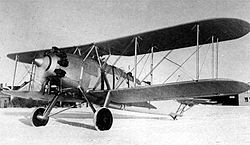Heinkel He 66
| Heinkel He 66 | |
|---|---|
 The HD 66 delivered to Japan |
|
| Type: | Dive and reconnaissance aircraft |
| Design country: | |
| Manufacturer: | |
| First flight: |
1933 |
| Commissioning: |
1934 |
| Number of pieces: |
1 (possibly +24) |
The Heinkel He 66 (original name HD 66 ) is a German dive and reconnaissance aircraft developed in the 1930s by Heinkel-Flugzeugwerke in Warnemünde and the export version of the HD 50 .
development
In December 1933, an HD 50 ordered by the Japanese company Aichi was shipped to Japan under the designation HD 66. There, under the direction of Aichi's chief designer Tokuichiro Gomei, it was equipped with a local Nakajima Kotobuki 2-Kai-1 drive with 580 hp (427 kW). Under the designation AB-9 , she then competed in a competition initiated by the Japanese Navy to select a dive bomber for the carrier mission against a pattern developed by Nakajima. It won the elimination and Aichi received the order for series production, which began the following year as the D1A1 .
In the literature there are sometimes contradicting information about other aircraft built, but there is no reliable evidence for this. In July 1934 twelve He 66 A models, Heinkel had changed his designation system to the abbreviation He in the spring of 1932 , were delivered to National China , to whom in January 1936 another twelve He 50s with the more powerful SAM-22 engine and NACA Hood as He 66 B should have followed, either supplied by Heinkel or from stocks of the Luftwaffe . These aircraft are said to have been used as reconnaissance aircraft in the Sino-Japanese war .
construction
The He 66 is a tensioned biplane in composite construction with a slight staggering and V-position of the wings. The fuselage consists of a welded tubular steel frame with shaped frames made of wood and fabric covering. The engine area is clad with removable aluminum sheets up to the crew cabins. The two-spar wings of the same span are connected by I-posts in two levels and crossed with wire. Both the upper and lower wings are equipped with ailerons coupled by bumpers. The tail unit is made of aluminum and is partly metal-clad and fabric-covered. All rudders are aerodynamically balanced, the elevator has a trim tab that can be adjusted during flight, the horizontal stabilizer is supported against the fuselage and braced against the vertical fin. The main landing gear is rigid, has no continuous axle and is equipped with high-pressure tires and wheel brakes. The tail spur is sprung.
Technical specifications
| Parameter | Data |
|---|---|
| crew | 2 (pilot, observer) |
| span | 11.50 m |
| length | 9.70 m |
| height | 4.15 m |
| Wing area | 34.80 m² |
| Wing loading | 64.20 kg / m² |
| Power load | 4.94 kg / hp |
| Empty mass | 1202 kg |
| Preparation mass | 1312 kg |
| Payload | 923 kg |
| payload | 200 kg |
| Takeoff mass | 2235 kg |
| drive | an air-cooled Neunzylinder- four-stroke - radial engine |
| Type | Siemens & Halske "Jupiter" VI 5.3 ( Bristol license) |
| Take-off power Combat and climb power Rated power Continuous power |
490 hp (360 kW) at 2200 rpm 480 hp (353 kW) at 1850 rpm near the ground 440 hp (324 kW) at 1800 rpm near the ground 380 hp (279 kW) at 1720 at 800 m above sea level |
| Top speed | 245 km / h near the ground 247 km / h at 2000 m altitude 232 km / h at 4000 m altitude |
| Cruising speed at 85% take-off power |
185 km / h near the ground 190 km / h at 2000 m altitude 176 km / h at 4000 m altitude |
| Landing speed | 90 km / h |
| Rise time | 4.0 min at 1000 m altitude 8.8 min at 2000 m altitude 14.7 min at 3000 m altitude |
| opt. Range | 550 km at an altitude of 600 m at a maximum speed of 680 km at an altitude of 600 m at a maximum cruising speed of 810 km |
| Summit height | 5700 m |
| Take-off run | 270 m |
| Take-off distance up to 15 m | 435 m |
| Landing distance from a height of 15 m | 400 m |
literature
- Heinkel . Chronicle and data sheets from Heinkel-Flugzeugbau. 3. Edition. Aviatic, Oberhaching 1996, ISBN 3-925505-08-3 .
- Volker Koos: Ernst Heinkel Flugzeugwerke 1922–1932 . Heel, Königswinter 2006, ISBN 3-89880-502-6 .
- Helmut Stützer: The German military aircraft 1919–1934 . E. S. Mittler & Sohn, Herford 1984, ISBN 3-8132-0184-8 .
